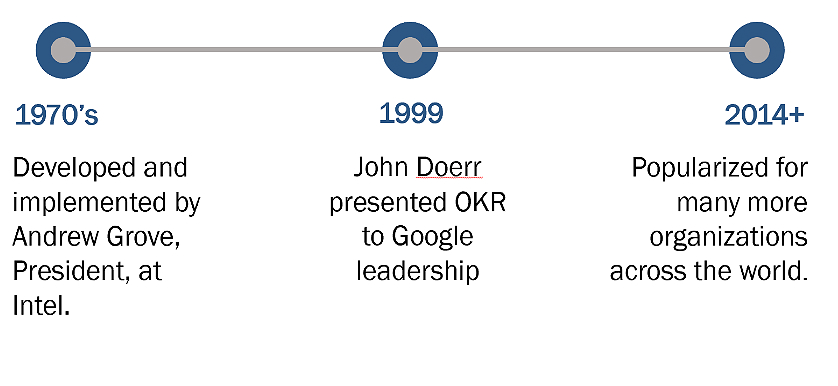OKR Essentials: Simplified Performance Management

Image Source: Pixabay
Most professionals interested in performance management must have heard by now about a new hip approach – Objectives and Key Results (OKRs). So, what is it all about? Why is everyone so mesmerized by this new system?
Some may argue that the OKR format became popular because companies with strong brands, such as Google or LinkedIn, credit their success to OKRs. Some might say that it is just another, more flexible, way of working with KPIs.
Others claim that OKRs are simply operational measures, while KPIs reflect the achievement of the strategy. However, supporters of the system state that OKRs represent a tool to create a link between the vision and the reality of an organization.
So, as we can see, there are many ways of interpreting them, but what is the truth behind OKRs and how did they become so popular? Do they really bring superior benefits to organizations compared to other performance management systems or are they used simply because KPIs are starting to be too “mainstream” and the field needed something new?
Timeline of OKR Popularity

Figure 1. OKR Timeline | Source: Author’s Compilation Based on Step by Step Guide to OKRs
OKR Components
Objectives and Key Results is a goal-setting methodology deriving from Management by Objectives, which tries to simplify the concept of performance management. The main goal of this approach is to be easy to use, flexible and answers 3 main questions:
- Where do I want to go?
- How will I know I’m getting there?
- What will I do when I arrive?

Figure 2. OKR Questions | Source: Author’s Compilation Based on Step by Step Guide to OKRs
Read More >> How Do OKRs Foster a High-Performance Culture?
Business Improvement through OKRs
OKRs are there to better serve fast-changing, agile businesses and environments, given that this system requires regular updates and feedback, as well as employs a smaller time span for changing objectives or key results.
The main changes an OKR-focused system brings are the following:
- The achievement of our actions or of what we want to do is supposed to be stretched (60-70% achievable) and set quarterly. In other words, the OKR methodology encourages employees and organizations to set inspirational, challenging, higher-risk objectives, not just operational ones. The purpose is to strive to do more, which is why a lower achievement than 100% is considered good. The number of objectives is limited to a maximum 5 to ensure employees are focusing on the most important work for one quarter at a time.
- Everyone should be involved in the OKR-setting process and employees should be responsible for creating their own OKRs. This automatically creates more empowerment and accountability for the value their job brings. The process of empowering employees to think outside the box, and allowing them to take risks, will result in higher employee engagement. By not just focusing on day-to-day activities and taking part in a more creative process, your workforce will be able to generate increased levels of innovation as well.
- The Value creation theory says Key Results should focus on the impact of activities, not measure the result of the tasks. Setting Key Results that trigger going the extra mile for each employee will create even more value for the entire organization, which will allow it to go even further than planned.
- Objectives and Key Results should focus on alignment, not cascading. When setting their own OKRs, employees should take into consideration they own responsibilities, the strategic direction, the already-established OKRs or the management’s aspirations in the organizational context. It is recommended that an employee’s OKRs are actionable by that person, so it’s harder to assign OKRs or create a set of general OKRs for a position.
- Given that OKRs are set quarterly and designed to stimulate constant communication, this tool offers more flexibility that the others. It allows fast changes through weekly or biweekly progress checks and makes sure that the focal point is reconsidered each quarter.
Read More >> How To Choose a Performance Framework That Fits Your Company
Changing Organizational Cultures
However, after all is said and done, we have to remember that the main change OKRs bring is cultural.
- Instead of only giving employees objectives and KPIs, employees should understand the strategy, in order to be able to align their OKRs to the strategy or the management’s.
- Instead of being given the measures of their performance, employees are involved in setting the focus of their quarterly work.
- Instead of measuring the performance of the employees based only on what they have to do, employees are measured based on the value they bring and are offered the flexibility to work on innovative ideas, which might in return bring a lot of benefits to the organizations.
- Instead of linking performance with rewards and making sure employees do what they need to do because of incentives, organizations try to engage employees, to make them part of the vision.
As we can see, when implementing Objectives and Key Results, the process feels a lot more back-and-forth than other management methods.
On the one hand, managers play a key role since they need to challenge their employees to consider the value they bring to the organization, as well as offer them support and stimulate regular communication on their OKRs’ status.
On the other, employees represent an equivalent key player, since they need to set their OKRs and be honest with themselves in the process, trying to set challenging OKRs and be willing to go the extra mile.
Visit our website to read more articles covering OKRs and other similar performance management concepts.**********
Editor’s Note: This article is part of an ongoing series that will feature practical tips and tricks we’ve learned while implementing the OKR system within various organizations. This article has been updated as of September 17, 2024
Tags: Key Performance Indicators, KPI, Objectives and Key Results, OKR





